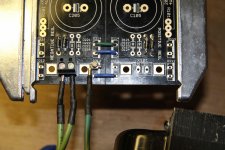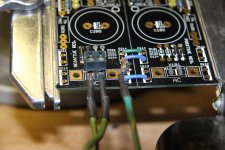The picture below shows a standard split rail rectifier using a single bridge. You can use individual diodes.
Is this what you are trying to achieve?
Jeremy
Jeremy, I think that pic is wrong, it's wrong on the site it came from, the bridge is connected the wrong way. I think it should be like it is shown here: Bridge Rectifier, Power supplies
Hi i was wondering if someone could help me with my salas shunt modules from the tda1541 red baron dac forum, the positive regulation works but the negative modules arent working at all voltage in is good and has negative volts going in but no reguation, leds arent lighting up and cant adjust negative voltage, thanks if anyone could give some advise
Hi i was wondering if someone could help me with my salas shunt modules from the tda1541 red baron dac forum, the positive regulation works but the negative modules arent working at all voltage in is good and has negative volts going in but no reguation, leds arent lighting up and cant adjust negative voltage, thanks if anyone could give some advise
Are the 4 LEDs in backwards possibly?. It's not like I don't do that all the time
Hi Salas,
Please advice what Ele-cap would be a good choice for C102/C202/C302 with 50V. In my case, Nichicon KZ and Elna RFS are both 16 mm dia. It is too big for me. I need something 10 - 12.5 mm MAX.
How bout Panasonic FC or FR? They are both 10 mm in dia.
I'm not sure about quality vs. Elna or Nichicon and low impedance caps usage in that position...
Thank you.
Please advice what Ele-cap would be a good choice for C102/C202/C302 with 50V. In my case, Nichicon KZ and Elna RFS are both 16 mm dia. It is too big for me. I need something 10 - 12.5 mm MAX.
How bout Panasonic FC or FR? They are both 10 mm in dia.
I'm not sure about quality vs. Elna or Nichicon and low impedance caps usage in that position...
Thank you.
C102/C202/C302 are film cap positions. C101/C201/C301 are ecap positions. Nichicon Muse KZ 100uF 50V is 12.5mm for instance. Which is enough of filtering if not for a particularly noise sensitive application. 220uF 35V Nichicon Muse ES BP is 12.5mm too if Vout<35V. Then there are the FC & FR of course. Which are very long life and good quality in general.
C102/C202/C302 are film cap positions. C101/C201/C301 are ecap positions. Nichicon Muse KZ 100uF 50V is 12.5mm for instance. Which is enough of filtering if not for a particularly noise sensitive application. 220uF 35V Nichicon Muse ES BP is 12.5mm too if Vout<35V. Then there are the FC & FR of course. Which are very long life and good quality in general.
Got you. I need 50V since I use about 40-45V out.
So, I'll use Pan FR 270uF 50v. I have them in my stock.
Thank you.
I'm sure this is answered elsewhere in this thread but I'm gonna be a bit lazy and ask rather than trawling through several hundred pages...
I've recently taken delivery of some minikits courtesy of Tea-Bag; excellent service btw.
I plan to use the kits for +/- 24V supplies for some DAC I/V modules and have worked through the calculator spreadsheet and I'm confident of setting up the PCBs correctly. I imagined that I would connect the secondaries of my transformer to the appropriate connections on the PCB but the calculator has an additional worksheet for a pre-filter but I'm assuming this is an option to 'ice the cake'? Is my assumption correct or should I use a pre-filter?
Thanks
Ray
I've recently taken delivery of some minikits courtesy of Tea-Bag; excellent service btw.
I plan to use the kits for +/- 24V supplies for some DAC I/V modules and have worked through the calculator spreadsheet and I'm confident of setting up the PCBs correctly. I imagined that I would connect the secondaries of my transformer to the appropriate connections on the PCB but the calculator has an additional worksheet for a pre-filter but I'm assuming this is an option to 'ice the cake'? Is my assumption correct or should I use a pre-filter?
Thanks
Ray
Thanks for clarifying Salas. I think I'll leave out the pre-filter, at least to start with.
While I have your attention! Your build guide says to use a 50VA transformer (80VA for hot-rodding). I'm looking for each module to deliver 250-300mA @ +/-24V (100mA load, 150-200mA shunt) and would like to use a transformer I have already to hand; it has 25VA secondary windings rated at 25V 1A and I propose using one secondary per regulator board. It feels like the transformer is up to the job but am I missing something that says I should go with the build guide spec (or somewhere in between)?
Ray
While I have your attention! Your build guide says to use a 50VA transformer (80VA for hot-rodding). I'm looking for each module to deliver 250-300mA @ +/-24V (100mA load, 150-200mA shunt) and would like to use a transformer I have already to hand; it has 25VA secondary windings rated at 25V 1A and I propose using one secondary per regulator board. It feels like the transformer is up to the job but am I missing something that says I should go with the build guide spec (or somewhere in between)?
Ray
When you got >three times the asked amperage capacity (1A/0.3A) per secondary you will surely not end up with a hot transformer. Bigger transformers have lower impedance and enough users seem to appreciate that subjectively. Since the pricing step is not that awful its more of an all currents all builders happy blanket recommendation than a strict electrical one.
I imagined that I would connect the secondaries of my transformer to the appropriate connections on the PCB but the calculator has an additional worksheet for a pre-filter but I'm assuming this is an option to 'ice the cake'? Is my assumption correct or should I use a pre-filter?
Thanks
Ray
As Salas says, it's just an option, however, I found that by simply upgrading the transformer the sound improved, as did changing the big smoothing cap. So if you have the patience you will notice differences when you alter the circuit-good and bad.
Sorting through my spares box I found a couple of small power supply boards that I could easily use for a CR prefilter; the boards have pads for rectifiers and a cap and I can put a resistor across the regulator pads.
Question 1 - worth doing?
Question 2 - recommended values for the C & R.
I'll be using the Salas regs to power hybrid I/V modules; target output is 24V @ 400-450mA (inc shunt, load is 200mA)
Thanks
Ray
Question 1 - worth doing?
Question 2 - recommended values for the C & R.
I'll be using the Salas regs to power hybrid I/V modules; target output is 24V @ 400-450mA (inc shunt, load is 200mA)
Thanks
Ray
After Dr. Johnson had returned from a visit with Boswell to Fingal’s Cave in Scotland he was asked whether it was worth seeing. He replied that is was indeed worth seeing but not worth the effort of seeing.
So I think you will notice differences if you put in a filtering network before the reg, but it may not be worth the effort. I would concentrate on a really good quality transformer with static shield (my preference) and a good quality cap on Salas's board (my preference is 10,000uF, 63V Mundorf). Probably overkill but I stick with what has worked in the past.
I think good design is as much about what to leave out as it is what to put in.
So I think you will notice differences if you put in a filtering network before the reg, but it may not be worth the effort. I would concentrate on a really good quality transformer with static shield (my preference) and a good quality cap on Salas's board (my preference is 10,000uF, 63V Mundorf). Probably overkill but I stick with what has worked in the past.
I think good design is as much about what to leave out as it is what to put in.
and...
I would add that choosing some very "quiet" soft recovery diodes is probably worth the effort. Like Stealth, QSpeed, or ON MSRF...
After Dr. Johnson had returned from a visit with Boswell to Fingal’s Cave in Scotland he was asked whether it was worth seeing. He replied that is was indeed worth seeing but not worth the effort of seeing.
So I think you will notice differences if you put in a filtering network before the reg, but it may not be worth the effort. I would concentrate on a really good quality transformer with static shield (my preference) and a good quality cap on Salas's board (my preference is 10,000uF, 63V Mundorf). Probably overkill but I stick with what has worked in the past.
I think good design is as much about what to leave out as it is what to put in.
I would add that choosing some very "quiet" soft recovery diodes is probably worth the effort. Like Stealth, QSpeed, or ON MSRF...
- Home
- Amplifiers
- Power Supplies
- SSLV1.1 builds & fairy tales


